
Light rail transit (LRT) is a form of passenger urban rail transit characterized by a combination of tram and metro features. While its rolling stock is more similar to a traditional tram, it operates at a higher capacity and speed, and often on an exclusive right-of-way. In many cities, light rail transit systems more closely resemble, and are therefore indistinguishable from, traditional underground or at-grade subways and heavy-rail metros.
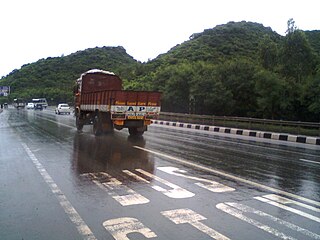
A bus stop is a place where buses stop for passengers to get on and off the bus. The construction of bus stops tends to reflect the level of usage, where stops at busy locations may have shelters, seating, and possibly electronic passenger information systems; less busy stops may use a simple pole and flag to mark the location. Bus stops are, in some locations, clustered together into transport hubs allowing interchange between routes from nearby stops and with other public transport modes to maximise convenience.

The San Francisco Municipal Railway (SF Muni or Muni) is the public transit system for the City and County of San Francisco. Despite the name, the network has 54 bus lines and 17 trolleybus lines, in addition to seven light rail lines that operate above ground and in the city's lone subway tube, three historic cable car lines, and two historic streetcar lines.
The Central New York Regional Transportation Authority, commonly referred to as Centro, is a New York State public benefit corporation and the operator of mass transit in Onondaga, Oswego, Cayuga, and Oneida counties in New York state. The CNYRTA was formed on August 1, 1970, along with similar agencies in Rochester, Albany, and Buffalo.
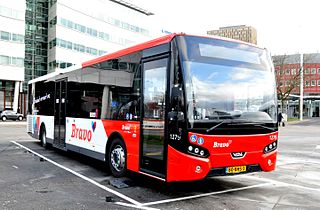
A transit bus is a type of bus used on shorter-distance public transport bus services. Several configurations are used, including low-floor buses, high-floor buses, double-decker buses, articulated buses and midibuses.

A tourist trolley, also called a road trolley, is a rubber-tired bus designed to resemble an old-style streetcar or tram, usually with false clerestory roof. The vehicles are usually fueled by diesel, or sometimes compressed natural gas.

People in the San Francisco Bay Area rely on a complex multimodal transportation infrastructure consisting of roads, bridges, highways, rail, tunnels, airports, seaports, and bike and pedestrian paths. The development, maintenance, and operation of these different modes of transportation are overseen by various agencies, including the California Department of Transportation (Caltrans), the Association of Bay Area Governments, San Francisco Municipal Transportation Agency, and the Metropolitan Transportation Commission. These and other organizations collectively manage several interstate highways and state routes, two subway networks, two commuter rail agencies, eight trans-bay bridges, transbay ferry service, local bus service, three international airports, and an extensive network of roads, tunnels, and bike paths.

The San Diego Metropolitan Transit System is a public transit service provider for Central, South, Northeast and Southeast San Diego County. The agency directly operates a large transit system that includes the MTS Bus, San Diego Trolley light rail, and Rapid bus rapid transit services. The MTS also controls the San Diego and Arizona Eastern (SD&AE) freight railway and regulates taxicabs, jitneys, and other private for-hire passenger transportation services.

Streetcars or trolley(car)s were once the chief mode of public transit in hundreds of North American cities and towns. Most of the original urban streetcar systems were either dismantled in the mid-20th century or converted to other modes of operation, such as light rail. Today, only Toronto still operates a streetcar network essentially unchanged in layout and mode of operation.
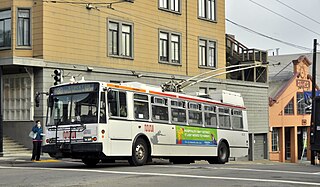
Electric Transit, Inc. (ETI) was a joint venture between the Škoda group in the Czech Republic and AAI Corporation in the United States which made trolleybuses for the Dayton and San Francisco trolleybus systems, constructing a total of 330 trolleybuses. ETI was formed in 1994, and ownership was divided as 65% by Škoda and 35% by AAI. The latter was a wholly owned subsidiary of United Industrial Corporation. Up to that time, Škoda had built more than 12,000 trolleybuses since 1935, but none for cities outside Europe and Asia. The ETI joint venture was dissolved in 2004, shortly after an unsuccessful bid to supply trolleybuses to Vancouver.
In public transportation, schedule adherence or on-time performance (OTP) refers to the level of success of the service remaining on the published schedule. On time performance, sometimes referred to as on time running, is normally expressed as a percentage, with a higher percentage meaning more vehicles are on time. The level of on time performance for many transport systems is a very important measure of the effectiveness of the system.
A vehicle tracking system combines the use of automatic vehicle location in individual vehicles with software that collects these fleet data for a comprehensive picture of vehicle locations. Modern vehicle tracking systems commonly use GPS or GLONASS technology for locating the vehicle, but other types of automatic vehicle location technology can also be used. Vehicle information can be viewed on electronic maps via the Internet or specialized software. Urban public transit authorities are an increasingly common user of vehicle tracking systems, particularly in large cities.

Salesforce Transit Center is a transit station in downtown San Francisco. It serves as the primary bus terminal — and potentially as a future rail terminal — for the San Francisco Bay Area. The centerpiece of the San Francisco Transbay development, the construction is governed by the Transbay Joint Powers Authority (TJPA). The 1,430-foot (440 m)-long building is located one block south of Market Street, a primary commercial and transportation artery in San Francisco.

Public transport is a system of transport for passengers by group travel systems available for use by the general public unlike private transport, typically managed on a schedule, operated on established routes, and that charge a posted fee for each trip. There is no rigid definition; the Encyclopædia Britannica specifies that public transportation is within urban areas, and air travel is often not thought of when discussing public transport—dictionaries use wording like "buses, trains, etc." Examples of public transport include city buses, trolleybuses, trams and passenger trains, rapid transit and ferries. Public transport between cities is dominated by airlines, coaches, and intercity rail. High-speed rail networks are being developed in many parts of the world.
Transdev, formerly Veolia Transdev, is a French-based international private-sector company which operates public transport. It has operations in 17 countries and territories as of November 2020.

SolTrans, officially Solano County Transit, is a Joint Powers Authority that provides public transportation service to the southern Solano County cities of Vallejo and Benicia. SolTrans was established in 2011 and is the result of a merger between Vallejo Transit and Benicia Breeze. In 2021, the system had a ridership of 477,400, or about 1,800 per weekday as of the fourth quarter of 2021.
Cubic Corporation is an American public transportation and defense corporation. It operates two business segments: Cubic Transportation Systems (CTS) and Cubic Mission and Performance Solutions (CMPS).
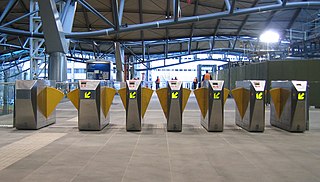
An automated fare collection (AFC) system is the collection of components that automate the ticketing system of a public transportation network - an automated version of manual fare collection. An AFC system is usually the basis for integrated ticketing.
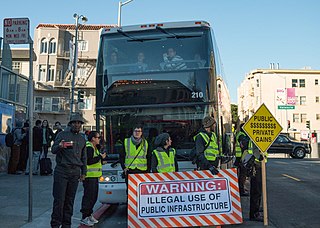
The San Francisco tech bus protests were a series of community-based activism held by residents of the San Francisco Bay Area beginning in late 2013, when the use of shuttle buses employed by local area tech companies became widely publicized. The tech buses have been called "Google buses" although that term is pars pro toto, in that many other tech companies such as Apple, Facebook, Yahoo and Genentech also pay for private shuttle services.

MTA Bus Time, stylized as BusTime, is a Service Interface for Real Time Information, automatic vehicle location (AVL), and passenger information system provided by the Metropolitan Transportation Authority (MTA) of New York City for customers of its bus operations under the New York City Bus and MTA Bus Company brands. First tested in late 2010 and officially launched in early 2011, MTA Bus Time was installed in all MTA bus routes in New York City by 2014.















